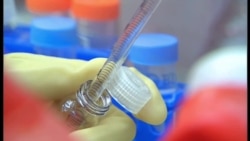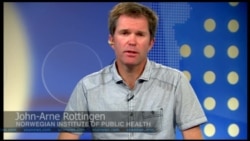The head of the scientific group that designed and oversaw the field test in Guinea says international collaboration and community involvement were key to the successful trial of a new Ebola vaccine.
In a break with traditional research methods, the team working on the Ebola vaccine did not use placebos on a control group. Instead they devised a "ring approach," administering vaccine to everyone in small groups considered most at risk of contracting the virus. Results were compared between those who received vaccinations immediately after an infection was detected and those who got the drug three weeks later.
Such "rings" of vaccination took place either immediately after an Ebola infection was confirmed or three weeks later, according to the researchers' random assignments. Of 2,014 people vaccinated immediately, no one had contracted Ebola when tested 10 days after receiving the new drug. In the clusters where people were vaccinated three weeks later — 2,380 people — 16 people contracted the virus.
WATCH: John-Arne Rottingen discusses vaccine trials
In an interview with VOA, John-Arne Røttingen, director of the Division of Infectious Disease Control at the Norwegian Institute of Public Health, said his institute worked closely with Guinean representatives, international health organizations and researchers from other academic institutions to design and conduct the vaccine test, which involved thousands of people.
“We decided to have a very kind of local profile,” in order to persuade local residents to take part in the trial vaccinations, "Røttingen said in an interview from Norway.
“Almost 80, 90 percent of all those who have contributed in the trial on the ground in both follow-up teams and vaccination teams, they are from Guinea or from other West African countries,” he said.
“We wanted people with expertise in the local culture, and also knowledge of local languages, to be the ones who could go out to the different villages and the different communities and start a discussion on the potential involvement in a trial,” he explained.
In many cases, it was necessary to explain to the potential test subjects what a vaccination is and how it could help to protect them from Ebola.
“We started with local people who had knowledge of the society who went out to the communities and started a dialogue with the chief of the village or the chief of the community and potentially also religious leaders,” Røttingen said.
“When there was a trust established, an agreement, then at that stage we moved in with the vaccination teams.”
Røttingen said the group decided against providing a placebo, or non-effective vaccine, to a control group because they wanted to be sure to provide protection against Ebola for all those in the trial in the event the vaccine was effective.
“What we did was to follow the epidemic in a way, we identified contacts of new cases, and also contact of their contacts, and therefore we identified a ring of high-risk individuals. And those were the ones who were enrolled in the study.”
WATCH: John-Arne Rottingen discusses effectiveness of vaccine
Røttingen pointed out that the vaccine, while apparently effective, is still not licensed for general use. He said additional testing is needed, not only to verify the initial results but also as a way to continue offering protection against Ebola to those at risk from the disease.
The Norwegian scientist said the latest medical breakthrough could provide a “platform” for developing vaccines against other hemorrhagic viruses, but that the kind of international cooperation that produced the Ebola vaccine will be key to future successes.
“I think that is potentially the most important learning from the Ebola vaccination and vaccine development processes during this outbreak, that we have demonstrated that by good coordination and strong collaboration, the world is able to actually develop new technologies at high speed,” he said.
“So we should really utilize this experience to also go ahead with other emerging diseases and other important infections.”











